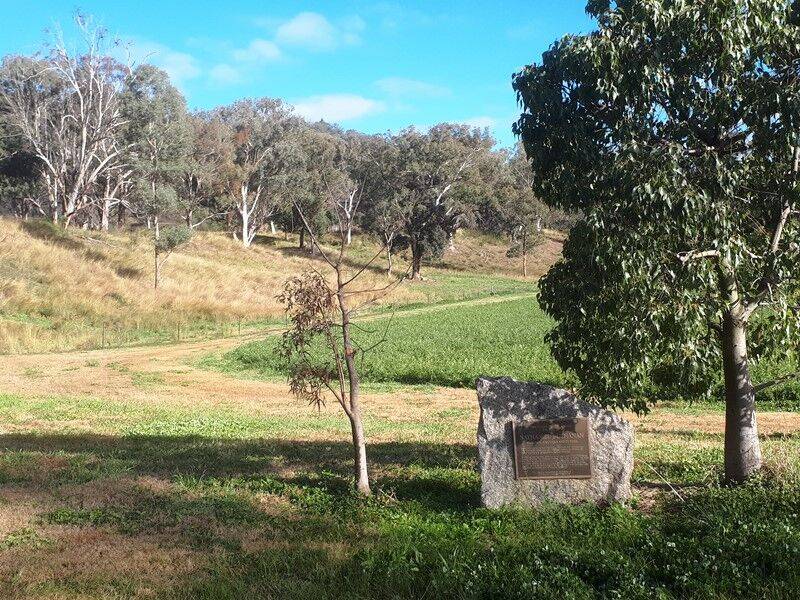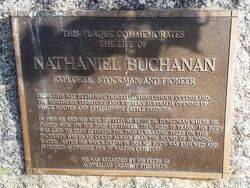
Nathaniel BuchananPrint Page 
The plaque commemorates Nathaniel Buchanan.
Nathaniel (Nat) Buchanan (1826 - 1901), arrived in Sydney in January 1837 with his parents and four brothers, and the family settled at Rimbanda in New England in 1839. Ten years later Nat and his brothers Andrew and Frank joined the rush to the Californian goldfields; unlucky, they worked their way back on a windjammer and on their return had to surrender the station they had bought and worked before leaving. Nat took to droving between New South Wales and the Victorian goldfields.
In 1859 he joined the explorer, William Landsborough, and they set out from Rockhampton to look for grazing land. They investigated country watered by the tributaries of the Fitzroy and the Belyando Rivers and then headed further west. They secured 3885 square kilometres on the Thomson River it in 1863 with capital supplied by Robert Morehead of the Scottish Australian Company.
Nat was sent as first manager and partner in the Landsborough River Company to pioneer Bowen Downs station. A few months earlier he had led a group of men to blaze a stock route from Port Denison (Bowen) to the runs, which were 483 kilometres inland. He married in 1863 and took his bride Catherine to the barely established station where she was then the only European woman in the district.
Nat continued to make excursions into the country north and west of Bowen Downs. His reputation as a bushman was already established and his sense of direction and locality was unrivalled, but he left no account of his journeys and hardly more of his activities as manager of Bowen Downs. In 1864 the company sent him on a race against time and a Sydney syndicate to secure the best land on the Gulf near Burketown; he won, but within a few years the foothold was relinquished in the wake of fever and disease. Drought threatened the continuance of Bowen Downs and in 1867 Nat walked out, abandoning his one-eighth share to Morehead and the Scottish Australian Company. For a while he farmed a selection on the Bellinger River in New South Wales with his brother Andrew; he mined at Watson's Creek and then accepted the management of Craven station near Emerald in Queensland, and took his wife and son Gordon who was born in 1864 with him.
As an experienced explorer and drover in the area west of the Georgina River, Nat was given contracts to pilot cattle from Burketown to the head of that river. In 1877 he and Sam Croker left Rocklands station to cross the Barkly Tableland and ride on to the Overland Telegraph Line, thus making known to city map speculators the result of their land gamble. Almost no land was left for the two explorers when they telegraphed their claims for pastoral leases. Nat's next trip in 1878 was the famed first stocking of Glencoe station in the Northern Territory: 1200 cattle from Aramac in Queensland to the Adelaide River with no predefined route and no settlement for approximately 1600 kilometres. On this journey he had three drays and seven European men. The cook was decapitated by hostile aboriginals while making food. Supplies diminished rapidly until Nat returned just in time with relief from Katherine, but the delays saved the calves and the mob increased during the journey.
The overlanders of the 1880s followed Nat's route from Burketown to the McArthur River, to the Roper and on to Katherine. Nat himself retraced his steps to Glencoe with 20,000 cattle for Charles Fisher in 1880. With the Gordon brothers, as on the previous trip, he organized the move in ten separate parties, each with about seven men; again there were threats of aboriginal attack, hazards and delays of flood and dry seasons, crocodiles and fever. He was first to take cattle into the Kimberley, crossing the Victoria River country with 4000 head to stock the Ord River station in 1883. This was the route used by gold seekers flocking to the Kimberley fields in 1886, although yet another track, the Murranji which was shorter by approximately 64o kilometres had been pioneered that year by Nat with his son and Sam Croker.
Nat and the Gordon brothers took up Wave Hill on the Victoria River in 1883, one of the first stations established west of the Telegraph Line, in rich but remote cattle country. Although then in partnership with his wealthy brother, W. F. Buchanan, Nat's fortune was still unmade, and his search for ways of solving the enormous problems facing the East Kimberley pastoralist was characteristically practical and personal. In 1890 he shipped thirty Wave Hill bullocks from Derby to Singapore, accompanying the shipment himself but returning with a profit too small to justify a second venture. Two years later he went to the Murchison goldfields, blazing a route which became known as Buchanan's Track, but the hoped-for market was closed to East Kimberley cattle next year. In 1894 Nat surrendered Wave Hill to his brother. He lived for a while at Flora Valley, the property taken up by his son in 1887, but he went on to mine at Mount Bradley in the Kimberley and later to manage Ord River station for a year.
At 70 he made his last big expedition, exploring land between Tennant's Creek and Sturt Creek in an effort to find a route from the Barkly Tableland to Western Australia. The South Australian Government provided him with camels, and his only assistant was a aboriginal driver who showed signs of deserting and at night was handcuffed to the leading camel. No practicable route was found. Nat made other shorter trips, searching for mica east of Tanami and exploring south of Hooker's Creek until in 1899, acting on doctor's orders to leave the area, he bought Kenmuir, a farm on Dungowan Creek near Tamworth. There 10 hectares of lucerne kept him active until he died on 23 September 1901, survived by his wife and son.
Location
| Address: | 2 Thorntons Road, Dungowan, 2340 |
|---|---|
| State: | NSW |
| Area: | AUS |
| GPS Coordinates: | Lat: -31.263901 Long: 151.202555 Note: GPS Coordinates are approximate. |
Details
| Monument Type: | Plaque |
|---|---|
| Monument Theme: | People |
| Sub-Theme: | Industry |
Dedication
This plaque commemorates the life of Nathaniel Buchanan
Explorer, stockman and pioneer
From 1859 Nat Buchanan travelled throughout Queensland, the Northern Territory and Western Australia opening up stock routes and establishing cattle stations.
In 1899 he and his wife settled at Kenmuir, Dungowan where he passed away on the 23rd September, 1901, aged 72 years.
His body was laid to rest between the two Kurrajong trees on this property where he could always hear the sound of running water. After his wife`s death in 1924 his body was exhumed and interred alongside her in Walcha Cemetery.
He was regarded by his peers as Australia`s greatest stockman.






